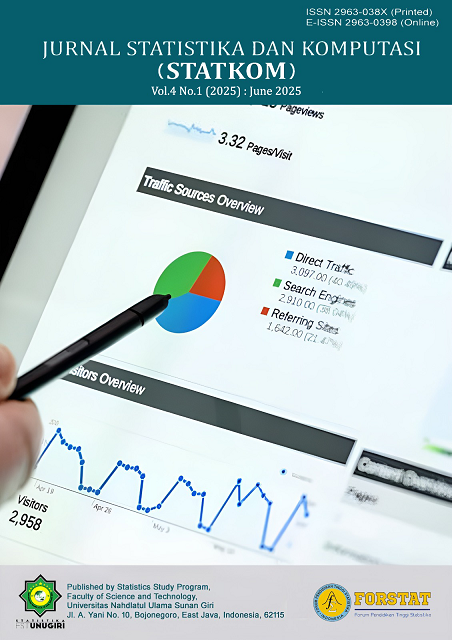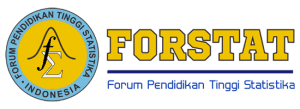Clustering Analysis of School Student Distribution in Bojonegoro Regency with Kernel K-Means
 PDF Download: 98
SIMILARITY INDEX Download: 0
PDF Download: 98
SIMILARITY INDEX Download: 0
DOI:
https://doi.org/10.32665/statkom.v4i1.4825Keywords:
Education, Clustering, Kernel K-Means, Study Group DistributionAbstract
Background: Education is a fundamental aspect that plays an important role in determining the progress of a nation. In Indonesia, education equity remains a major challenge, particularly in relation to the gap between urban and rural areas. Bojonegoro District, with its diverse geographical and social characteristics, reflects this issue of uneven educational access.
Objective: This study aims to examine the 2022 distribution of study groups at different education levels (kindergarten, elementary school, junior high school, high school, and vocational school) in Bojonegoro using descriptive statistics, normality testing, and the Kernel K-Means clustering algorithm.
Methods: Data were tested for normality using the Kolmogorov-Smirnov method. The clustering was performed by comparing four kernel types (Dot, Polynomial, Gaussian, and Sigmoid) to determine the most effective approach based on the Average Within Cluster Distance (AWCD) and the elbow method principle.
Results: The findings indicate that the distribution of study groups at the kindergarten and elementary school levels is relatively even and follows a normal pattern. In contrast, the distributions at the junior high school, high school, and vocational school levels remain uneven. The Kernel K-Means algorithm with the Dot kernel produced the most optimal results, identifying five main clusters that reflect regional disparities in educational participation.
Conclusion: This study demonstrates the novelty of applying Kernel K-Means in the educational context to uncover spatial disparities. The resulting clusters offer valuable insights into education inequality in Bojonegoro. These insights can inform policymakers in designing more targeted, equitable, and data-driven education policies.
References
Azizah, F., & Athoillah, M. (2021). Analisis dampak Covid-19 terhadap indeks harga konsumen dengan K-Means dan regresi berganda. Indonesian Journal of Applied Statistics, 4(1), 21–33. https://doi.org/10.13057/ijas.v4i1.46329
Fitri, S. F. N. (2021). Problematika Kualitas Pendidikan di Indonesia. Jurnal Pendidikan Tambusai, 5(1), 1617–1620. https://jptam.org/index.php/jptam/article/view/1148
Fitriyah, H., Safitri, E. M., Muna, N., Khasanah, M., Aprilia, D. A., & Nurdiansyah, D. (2023). Implementasi Algoritma Clustering dengan Modifikasi Metode Elbow untuk Mendukung Strategi Pemerataan Bantuan Sosial di Kabupaten Bojonegoro. Jurnal Lebesgue: Jurnal Ilmiah Pendidikan Matematika, Matematika Dan Statistika, 4(3), 1598-1607. https://doi.org/10.46306/lb.v4i3.453
Kartini, A.Y., Nurdiansyah, D., & Cahyani, N. (2024). Metode Statistika. Madza Media.
Khan, A. S. S., Fatekurohman, M., & Dewi, Y. S. (2023). Perbandingan Algoritma K-Medoids Dan K-Means Dalam Pengelompokan Kecamatan Berdasarkan Produksi Padi Dan Palawija Di Jember. Jurnal Statistika Dan Komputasi, 2(2), 67–75. https://doi.org/10.32665/statkom.v2i2.2301
Kurniawati, F. N. A. (2022). Meninjau Permasalahan Rendahnya Kualitas Pendidikan Di Indonesia Dan Solusi. Academy of Education Journal, 13(1), 1–13. https://doi.org/10.47200/aoej.v13i1.765
Muiz, R. A. (2024). Comparison of K-Means and Fuzzy C-Means for Optimizing Tuberculosis Management and Healthcare Service Allocation in Bojonegoro. Jurnal Statistika Dan Komputasi, 3(2), 80–91. https://doi.org/10.32665/statkom.v3i 2.3532
Nurdiansyah, D., Ma’ady, M., Sukmawaty, Y., Utomo, M., & Mutiani, T. (2024). Clustering Analysis For Grouping Sub-Districts In Bojonegoro District With The K-Means Method With A Variety Of Approaches. BAREKENG: Jurnal Ilmu Matematika Dan Terapan, 18(2), 1095-1104. https://doi.org/10.30598/barekengvol18iss2pp1095-1104
Nurdiansyah, D., Saidah, S., & Cahyani, N. (2023). Data Mining Study For Grouping Elementary Schools In Bojonegoro Regency Based On Capacity And Educational Facilities. BAREKENG: Jurnal Ilmu Matematika Dan Terapan, 17(2), 1081-1092. https://doi.org/10.30598/barekengvol17iss2pp1081-1092
Quraisy, A. (2020). Normalitas Data Menggunakan Uji Kolmogorov-Smirnov dan Saphiro-Wilk. Journal of Health, Education, Economics, Science, and Technology, 3(1), 7-11. https://doi.org/10.36339/
Safitri, E. M. (2024). Clustering Study Of Hospitals In Bojonegoro Based On Health Workers With K-Means And K-Medoids Methods. Jurnal Statistika Dan Komputasi, 3(2), 92–102. https://doi.org/10.32665/statkom.v3i2.3592
Sholikhah, N. A. (2022). Studi Perbandingan Clustering Kecamatan di Kabupaten Bojonegoro Berdasarkan Keaktifan Penduduk Dalam Kepemilikan Dokumen Kependudukan. Jurnal Statistika Dan Komputasi, 1(1), 42–53. https://doi.org/10.32665/statkom.v1i1.443
Downloads
Published
Issue
Section
License
Copyright (c) 2025 Ahmad Zakki Mubarok

This work is licensed under a Creative Commons Attribution-ShareAlike 4.0 International License.
Authors who publish with this journal agree to the following terms:
- Authors retain copyright and grant the journal right of first publication with the work simultaneously licensed under a Creative Commons Attribution License - Share Alike that allows others to share the work with an acknowledgment of the work's authorship and initial publication in this journal.
- Authors are able to enter into separate, additional contractual arrangements for the non-exclusive distribution of the journal's published version of the work (e.g., post it to an institutional repository or publish it in a book), with an acknowledgment of its initial publication in this journal.
- Authors are permitted and encouraged to post their work online (e.g., in institutional repositories or on their website) prior to and during the submission process, as it can lead to productive exchanges, as well as earlier and greater citation of published work.
USER RIGHTS
All articles published Open Access will be immediately and permanently free for everyone to read and download. We are continuously working with our author communities to select the best choice of license options, currently being defined for this journal as follows:
 PDF Download: 98
SIMILARITY INDEX Download: 0
PDF Download: 98
SIMILARITY INDEX Download: 0












